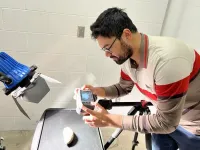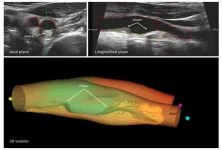(Press-News.org) URBANA, Ill. – Hyperspectral imaging is a useful technique for analyzing the chemical composition of food and agricultural products. However, it is a costly and complicated procedure, which limits its practical application. A team of University of Illinois Urbana-Champaign researchers has developed a method to reconstruct hyperspectral images from standard RGB images using deep machine learning. This technique can greatly simplify the analytical process and potentially revolutionize product assessment in the agricultural industry.
“Hyperspectral imaging uses expensive equipment. If we can use RGB images captured with a regular camera or smartphone, we can use a low-cost, handheld device to predict product quality,” said lead author Md Toukir Ahmed, a doctoral student in the Department of Agricultural and Biological Engineering (ABE), part of the College of Agricultural, Consumer and Environmental Sciences and The Grainger College of Engineering at Illinois.
The researchers tested their method by analyzing the chemical composition of sweet potatoes. They focused on soluble solid content in one study and dry matter in a second study — important features that influence the taste, nutritional value, marketability, and processing suitability of sweet potatoes. Using deep learning models, they converted the information from RGB images into hyperspectral images.
“With RGB images, you can only detect visible attributes like color, shape, size, and external defects; you can’t detect any chemical parameters. In RGB images you have wavelengths from 400 to 700 nanometers, and three channels — red, green, and blue. But with hyperspectral images you have many channels and wavelengths from 700 to 1000 nm. With deep learning methods, we can map and reconstruct that range so we now can detect the chemical attributes from RGB images,” said Mohammed Kamruzzaman, assistant professor in ABE and corresponding author on both papers.
Hyperspectral imaging captures a detailed spectral signature at spatial locations across hundreds of narrow bands, combining to form hypercubes. Applying cutting-edge deep learning-based algorithms, Kamruzzaman and Ahmed were able to create a model to reconstruct the hypercubes from RGB images to provide the relevant information for product analysis.
They calibrated the spectral model with reconstructed hyperspectral images of sweet potatoes, achieving over 70% accuracy in predicting soluble solid content and 88% accuracy in dry matter content, marking a significant improvement over previous studies.
In a third paper, the research team applied deep learning methods to reconstruct hyperspectral images for predicting chick embryo mortality, which has applications for the egg and hatchery industry. They explored different techniques and made recommendations for the most accurate approach.
"Our results show great promise for revolutionizing agricultural product quality assessment. By reconstructing detailed chemical information from simple RGB images, we're opening new possibilities for affordable, accessible analysis. While challenges remain in scaling this technology for industrial use, the potential to transform quality control across the agricultural sector makes this a truly exciting endeavor,” Kamruzzaman concluded.
The first paper, “Deep learning-based hyperspectral image reconstruction for quality assessment of agro-product,” is published in the Journal of Food Engineering [DOI: 10.1016j.jfoodeng.2024.112223]. Authors are Md. Toukir Ahmed, Ocean Monjur, and Mohammed Kamruzzaman.
The second paper, “Comparative analysis of hyperspectral Image reconstruction using deep learning for agricultural and biological applications,” is published in Results in Engineering [DOI: 10.1016/j.rineng.2024.102623]. Authors are Md. Toukir Ahmed, Arthur Villordon, and Mohammed Kamruzzaman.
Both studies were funded by the USDA Agricultural Marketing Service through the Specialty Crop Multistate Program grant AM21SCMPMS1010.
The third paper, “Hyperspectral image reconstruction for predicting chick embryo mortality towards advancing egg and hatchery industry,” is published in Smart Agricultural Technology [DOI: 10.1016/j.atech.2024.100533]. Authors are Md. Toukir Ahmed, Md. Wadud Ahmed, Ocean Monjur, Jason Emmert, Grirish Chowdhary, and Mohammed Kamruzzaman. Funding was provided by the USDA National Institute of Food and Agriculture, Award # 2023–67015–39154.
END
New imaging technique brings us closer to simplified, low-cost agricultural quality assessment
2024-09-30
ELSE PRESS RELEASES FROM THIS DATE:
Purdue-led TOMI project receives $3.5M grant to turn a decade of data into new tools and strategies for tomato farmers
2024-09-30
Purdue-led TOMI project receives $3.5M grant to turn a decade of data into new tools and strategies for tomato farmers
WEST LAFAYETTE, Ind. — Indiana ranks third in the nation for tomato production. Lori Hoagland, a professor in Purdue University’s Department of Horticulture and Landscape Architecture, recently received a third grant from the U.S. Department of Agriculture’s National Institute of Food and Agriculture (USDA-NIFA) for the Tomato Organic Management and ...
Could a bout of COVID protect you from a severe case of flu?
2024-09-30
More than 200 viruses can infect and cause disease in humans; most of us will be infected by several over the course of a lifetime. Does an encounter with one virus influence how your immune system responds to a different one? If so, how? Does it weaken your defenses, boost them, or have some other impact altogether?
These are questions Rockefeller University scientists from the Laboratory of Virology and Infectious Disease,headed by Charles M. Rice, and Weill Cornell Medicine’s Laboratory of Epigenetics and Immunity, headed by Steven Z. Josefowicz, teamed up to answer in a new study published in the journal Immunity. ...
When detecting depression, the eyes have it
2024-09-30
Hoboken, N.J., September 30, 2024 – It has been estimated that nearly 300 million people, or about 4% of the global population, are afflicted by some form of depression. But detecting it can be difficult, particularly when those affected don’t (or won't) report negative feelings to friends, family or clinicians.
Now Stevens professor Sang Won Bae is working on several AI-powered smartphone applications and systems that could non-invasively warn us, and others, that we may be becoming depressed.
“Depression is a major challenge,” says Bae. “We want to help.”
"And since most people in the world today use smartphones daily, this could ...
NRG Oncology trial implies the addition of atezolizumab concurrently to standard of care does not improve survival in limited-stage small cell lung cancer
2024-09-30
The addition of the cancer immunotherapy drug atezolizumab to the standard of care concurrent chemoradiation (cCRT) did not improve overall survival for patients with limited-stage small cell lung cancer (LS-SCLC) in the second planned interim analysis of the NRG Oncology/Alliance NRG-LU005 clinical trial. These results were recently reported during the Plenary Session of the American Society for Radiation Oncology Annual Meeting in Washington, DC.
“While atezolizumab given concurrently with chemoradiation did not improve survival, we have still learned quite a bit from these findings. With the success of the ADRIATIC trial ...
NRG Oncology trial supports radiotherapy and cisplatin should remain the standard of care for p16+ oropharyngeal cancer
2024-09-30
The NRG Oncology NRG-HN005 phase II/III clinical trial did not meet the non-inferiority criteria to proceed to the phase III portion of the study. The phase II portion of the NRG-HN005 evaluated two experimental treatment arms against a control arm for patients with p16-positive (p16+, accepted as a surrogate for HPV+ status), locoregionally advanced oropharyngeal cancer. The interim futility results were recently reported during the Plenary Session of the American Society for Radiation Oncology Annual Meeting in Washington, DC.
“This ...
Progression of subclinical atherosclerosis predicts all-cause mortality risk
2024-09-30
A study carried out at Mount Sinaí Fuster Heart Hospital in New York in collaboration with the Centro Nacional de Investigaciones Cardiovasculares (CNIC) in Madrid provides important new information about atherosclerosis, a disease in which lipids (cholesterol) and other substances accumulate in plaques on the arterial wall, causing the vessels to harden and narrow, and increasing the risk of severe cardiovascular conditions.
The study, published in The Journal of the American College of Cardiology (JACC), was led by Dr. Valentín Fuster, Director of the Cardiovascular ...
Presence of subclinical atherosclerosis is marker of mortality and its progression increases risk of death
2024-09-30
The progression of atherosclerosis in people who have no symptoms of it is independently associated with the risk of dying from any cause, according to a new study led by researchers from Mount Sinai Fuster Heart Hospital, published September 30 in the Journal of the American College of Cardiology.
This research is also the first to show that advanced imaging can detect atherosclerotic disease of the large vessels long before the appearance of symptoms—an approach that could be used worldwide to prevent cardiovascular disease and risk of death. Together, the findings ...
Wang unlocking complex heterogeneity in large spatial-temporal data with scalable quantile learning
2024-09-30
Lily Wang, Professor, Statistics, College of Engineering and Computing (CEC), received funding for the project: “Collaborative Research: Unlocking Complex Heterogeneity in Large Spatial-Temporal Data with Scalable Quantile Learning.”
Wang and her collaborator, Huixia Judy Wang, Department Chair and Professor of Statistics at The George Washington University, are developing scalable and efficient quantile learning techniques and theories to address challenges in analyzing large-scale heterogeneous spatial and temporal data. These new analytical techniques will have wide-ranging applications, revolutionizing scientists’ understanding of spatial and temporal ...
Heart transplant patients from socioeconomically deprived areas face higher risk for postoperative complications, earlier death than others
2024-09-30
Heart transplant patients who live in socioeconomically disadvantaged areas are more likely to experience post-surgical complications and die within five years than patients who live in more advantaged areas, even when those patients were transplanted at topnotch high-volume hospitals, new UCLA research suggests.
The findings, to be published September 30 in the peer-reviewed Journal of Heart and Lung Transplantation, the official publication of the International Society for Heart and Lung Transplantation, suggest that a lack of access ...
Research alert: skin barrier protein also protects against inflammation
2024-09-30
Researchers at University of California San Diego School of Medicine have identified a new mechanism underlying inflammatory skin diseases, such as psoriasis and seborrheic dermatitis. They found that a protein essential in forming the skin’s protective barrier (ZNF750) also plays a role in controlling inflammation in skin cells, shedding light on why some people are more susceptible to inflammatory skin diseases than others. The study paves the way for more effective and personalized therapies for these debilitating diseases and also offers broader ...



